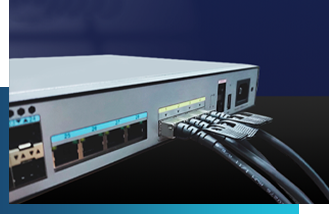
400 Gigabit Ethernet (400GbE) is the latest standard for high-speed data transmission, offering significant improvements over previous generations. To achieve 400GbE speeds, specialized transceivers are needed. These transceivers come in various types, each with its own characteristics and applications.
There are several types of 400G transceivers available, each suited for different network requirements and applications.
QSFP-DD (Quad Small Form-factor Pluggable Double Density): This is the most widely used form factor for 400G transceivers. It offers high density and supports various transmission distances and wavelengths.
OSFP (Optical Small Form-factor Pluggable): Another popular form factor gaining traction in the 400G market. It offers a smaller footprint compared to QSFP-DD and is well-suited for high-density applications.
QSFP112: An emerging form factor designed specifically for 400GbE and beyond. It offers even higher density and performance compared to QSFP-DD and OSFP.
SR8 (Short Reach): Up to 100 meters on multimode fiber, suitable for intra-datacenter connections.
DR4 (Direct Reach): Up to 500 meters on single-mode fiber, commonly used for data center interconnect (DCI).
FR4 (Long Reach): Up to 2 kilometers on single-mode fiber, ideal for longer-distance DCI applications.
LR4 (Extended Reach): Up to 10 kilometers on single-mode fiber, suitable for even longer-distance deployments.
CWDM4 (Coarse Wavelength Division Multiplexing): Multiplexes four 100Gb/s signals onto different wavelengths within a single fiber, enabling 400GbE over existing infrastructure.
BiDi (Bidirectional): Uses a single fiber for both transmitting and receiving data, maximizing fiber utilization and potentially reducing costs.
Selecting the right 400G transceiver is crucial for optimizing your network performance and efficiency. Here's a breakdown of key factors to consider:
Transmission distance: This dictates the type of transceiver you need. For short intra-datacenter links, SR8 (up to 100m) is suitable. For longer DCI connections, consider DR4 (up to 500m), FR4 (up to 2km), or LR4 (up to 10km).
Fiber type: Match the transceiver's fiber compatibility (multimode or single-mode) with your existing infrastructure.
Data rate: Ensure the transceiver supports the desired speed, typically 400GbE, but some offer dual-rate options like 100GbE.
Switch and router compatibility: Verify the transceiver is compatible with your specific network devices and switch ports. Consult vendor compatibility lists or contact the manufacturer for confirmation.
Form factor: QSFP-DD is the most common, but OSFP and QSFP112 are gaining traction. Choose based on your equipment and density requirements.
Different types and brands of transceivers have varying costs. Consider striking a balance between cost and features like reach, power consumption, and vendor warranty.
Power consumption: High-density environments might require prioritizing transceivers with lower power draw to manage thermal constraints.
Management features: Some transceivers offer digital optical monitoring (DOM) for real-time performance insights, which might be valuable for critical network links.
Vendor reputation and warranty: Opt for reputable brands offering reliable products and suitable warranty periods for peace of mind.
Data center interconnect (DCI): For longer DCI links, prioritize reach (FR4 or LR4) and potentially CWDM4 for maximizing existing infrastructure.
High-performance computing (HPC): Focus on low latency and high bandwidth within the cluster, prioritizing compatible transceivers for your HPC equipment.
Cloud computing: Similar to DCI, consider reach and potentially CWDM4 for dense cloud deployments.
400 Gigabit Ethernet (400GbE) transceivers are revolutionizing networks, offering exponential bandwidth leaps compared to previous generations. This significant speed surge unlocks opportunities across various industries:
High-performance computing (HPC): Interconnecting HPC clusters for parallel processing tasks requires massive data movement, which 400G transceivers facilitate seamlessly.
Storage systems: Enabling high-speed connections between servers and storage devices, ensuring efficient data access and retrieval.
Network backbones: Upgrading core data center networks to handle the ever-growing demands of cloud computing and virtualized environments.
Artificial intelligence (AI) and machine learning (ML): Supporting the massive data processing and transfer needs of AI and ML workloads.
Intra- and inter-datacenter connections: Building high-bandwidth connections within and between cloud data centers for efficient workload distribution and resource sharing.
Cloud service offerings: Delivering high-performance cloud services like streaming, gaming, and AI/ML applications to customers.
Edge computing: Enabling faster data processing and analysis at the network edge, crucial for applications like IoT and autonomous vehicles.
Metro and access network upgrades: Modernizing metro and access networks to handle increasing bandwidth demands for mobile backhaul and broadband internet access.
5G rollouts: Supporting the high bandwidth and low latency needs of 5G mobile networks.
Network expansion: Facilitating network expansion and reach, connecting geographically dispersed locations with high-speed links.
Network backbone upgrades: Upgrading enterprise network backbones for bandwidth-intensive applications like video conferencing, collaboration tools, and large file transfers.
Campus network connections: Connecting buildings and campuses within an organization's network with high-speed links.
Financial institutions: Ensuring high-speed and reliable data connectivity for demanding transaction processing.
Research and education networks: Facilitating high-speed data transfer for scientific collaborations and data analysis.
Healthcare networks: Enabling fast and reliable data access for medical imaging and patient records.
Manufacturing and automation: Supporting real-time data communication and control in industrial applications.
By deploying 400G transceivers, you're not just addressing current needs but also future-proofing your network for growing bandwidth demands. This proactive approach empowers you to accommodate emerging technologies and applications without network bottlenecks.
By understanding the different types of 400G transceivers and their applications, you can choose the right solution for your specific needs and upgrade your network to handle the ever-growing data demands.
